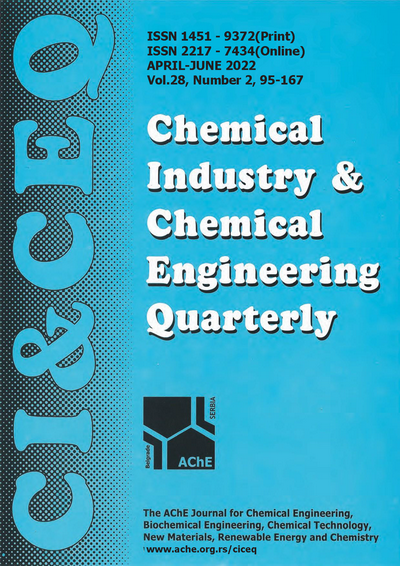THE REDUCTION OF FCCU AFTERBURNING THROUGH PROCESS OPTIMIZATION AND REGENERATOR REVAMPING
Scientific paper
DOI:
https://doi.org/10.2298/CICEQ210430023EKeywords:
FCCU, regenerator, afterburning, e-cat, cyclones, revampingAbstract
Operating the fluid catalytic cracking unit (FCCU) in afterburning conditions can increase the regenerator temperatures above the metallurgical design leading to mechanical failures of the cyclones and plenum chamber. This paper presents the methodology applied in a commercial FCCU to investigate the afterburning causes and the technical solutions that can be implemented to reduce the afterburning. Thus, by evaluating the regenerator temperature profile, regenerator as-build design, and the internals mechanical status, it was concluded that the main cause of afterburning was the non-uniform distribution and mixing of air and catalyst. The industrial results showed that optimizing the catalyst bed level, stripping steam, reaction temperature, and equilibrium catalyst (e-cat) activity reduced the afterburning by 39%. Other process parameters such as feed preheat temperature, slurry recycling, and excess oxygen did not significantly influence afterburning because of air and catalyst maldistribution. Revamping the regenerator to assure a symmetrical layout of cyclones reduced the afterburning by 86%, increased the fines retention in FCCU inventory, and provided a better regeneration of the spent e-cat. The reduction of operating temperatures at around 701°C removed the risk of catalyst thermal deactivation, and therefore the e-cat activity was increased by 10.2 wt.%.
References
P. Bai, U.J. Etim, Z. Yan, S. Mintova, Z. Zhang, Z. Zhong, X. Gao, Catal. Rev. 61 (2018) 335 – 405.
G.J. García, R.A. López, R.M. Yescas, Fuel 90 (2011) 3531 – 6541.
M. Clough, J.C. Popea, L. Tan, X. Lin, V. Komvokis, S. S. Pan, B. Yilmaz, Microporous Mesoporous Mater. 254 (2017) 45 – 58.
R. Sadeghbeigi, Fluid Catalytic Cracking Handbook (Third Edition), Elsevier Inc, Oxford (2012), 117 – 262.
J.A. Sexton, in Advances in Fluid Catalytic Cracking: testing, characterization and environmental regulations, M.L Occeli, CRC Press, Boca Raton (2010) 271 – 289.
R. Fletcher, M. Evans, Intercat (Johnson Matthey), Revamps PTQ (2010) 3 – 15. https://cdn.digitalrefining.com/data/digital_magazines/file/1420275728.pdf [accessed 25 May 2021].
J.R. Wilcox, in Advances in Fluid Catalytic Cracking: testing, characterization and environmental regulations, M.L. Occeli,
CRC Press, Boca Raton (2010) 101 – 118.
A.W. Chester, in Fluid Catalytic Cracking VII - Materials, Methods and Process Innovations; Studies in Surface Science and Catalysis, Vol. 166, M.L. Occelli, Elsevier, Amsterdam (2007) 67 – 77.
G. Davison, Guide to Fluid Catalytic Cracking, Part Two, W.R. Grace & Co.-Conn, J.W. Boarman Co. Baltimore, Maryland (1996) 155-156.
G. Davison, Guide to Fluid Catalytic Cracking, Part Three, W.R. Grace & Co.-Conn, J.W. Boarman Co. Baltimore, Maryland (1999) 255-284.
J. W. Wilson, FCC Regenerator Afterburn Causes and Cures, Wilson P.E., Barns and Click, Inc., AFPM Annual Meeting (2003) AM-03-44.
R. Butterfield, T. Ventham, P. Diddams, M. Evans, Hydrocarbon Engineering 22 (2017) 55-60.
F. Rosser, M. Schnaith, P.W. Walker, Integrated View to Understanding the FCC NOx Puzzle, AIChE Symposium, Austin, Texas (2004).
Z. Yang, Y. Zhang, T. Liu, O. Adefarati, Chemical Engineering Journal 421 (2021) 129694.
Z. Yang, Y. Zhang, O. Adefarati, J. Yue, Chemical Engineering Journal 412 (2021) 128634.
Y. Zhang, Baffles and Aids to Fluidization (Chapter 18), Essentials of Fluidization Technology, G. John, B. Xiaotao, E. Naoko (eds.). Wiley-VCH (2020) 431-455.
R. Fletcher, S. Clark, P. Blaser, Identifying the Root Cause of Afterburn in Fluidized Catalytic Crackers. AFPM Annual Meeting (2016) AM-16-15.
Y.M. Chen, Evolution of FCC - Past Present and Future and The Challenges of Operating a High Temperature CFB System, 10th International Conference on Circulating Fluidized Beds and Fluidization Technology - CFB-10, T. Knowlton, PSRI Eds., ECI Symposium Series (2013).
Downloads
Published
Issue
Section
License
Copyright (c) 2022 Florin Enache , Dan Dănulescu , Ion Bolocan , Diana Cursaru

This work is licensed under a Creative Commons Attribution-NonCommercial-NoDerivatives 4.0 International License.
Authors who publish with this journal agree to the following terms:
Authors retain copyright and grant the journal right of first publication with the work simultaneously licensed under a Creative Commons Attribution License that allows others to share the work with an acknowledgement of the work's authorship and initial publication in this journal.
Authors grant to the Publisher the following rights to the manuscript, including any supplemental material, and any parts, extracts or elements thereof:
- the right to reproduce and distribute the Manuscript in printed form, including print-on-demand;
- the right to produce prepublications, reprints, and special editions of the Manuscript;
- the right to translate the Manuscript into other languages;
- the right to reproduce the Manuscript using photomechanical or similar means including, but not limited to photocopy, and the right to distribute these reproductions;
- the right to reproduce and distribute the Manuscript electronically or optically on any and all data carriers or storage media – especially in machine readable/digitalized form on data carriers such as hard drive, CD-Rom, DVD, Blu-ray Disc (BD), Mini-Disk, data tape – and the right to reproduce and distribute the Article via these data carriers;
- the right to store the Manuscript in databases, including online databases, and the right of transmission of the Manuscript in all technical systems and modes;
- the right to make the Manuscript available to the public or to closed user groups on individual demand, for use on monitors or other readers (including e-books), and in printable form for the user, either via the internet, other online services, or via internal or external networks.




